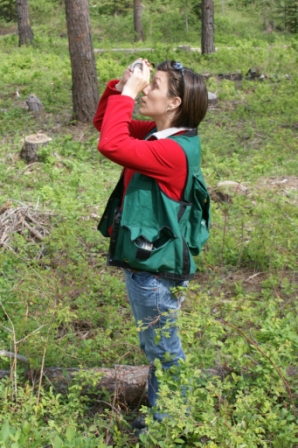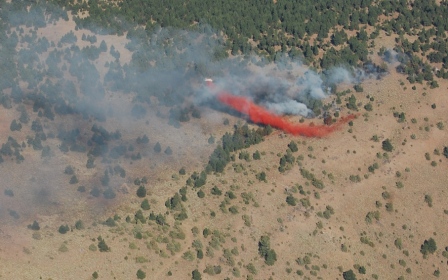 “You’re a forester?!” That’s a question I get a lot, even though I live in an area where money generated from the timber and related industries support large portions of local communities. For some, the idea of getting paid to spend time outdoors is fun to daydream about but completely impractical. After all, how many foresters are there and what do foresters do besides hang out in the woods?
“You’re a forester?!” That’s a question I get a lot, even though I live in an area where money generated from the timber and related industries support large portions of local communities. For some, the idea of getting paid to spend time outdoors is fun to daydream about but completely impractical. After all, how many foresters are there and what do foresters do besides hang out in the woods?
I just love being a forester. I get to work outside, interact with great people, visit classrooms, explore nature, perform aerial observations of forestland, assess fire risk, and fight fire. I wear many hats in my profession and I hope my story inspires others to pursue exciting careers in the outdoors.
Getting Students Interested in Outdoor Careers
When I visit elementary classrooms to share forestry-based lessons, initially I’m typically met with skepticism and uncertainty. The first thing I ask students is, “How many of you want to be a forester?” Not many, or sometimes no hands go up. Then I ask, “How many of you want to be outdoors?” If it’s a nice day and the sun is shining through the classroom windows, those same kids who have been cooped up in their classrooms begin to perk up. Now I have their attention!
I continue asking questions. “How many of you want to use cool gadgets at work, like iPads and other tablets, GPS units, or cameras?” More kids begin to look interested; this is, after all, the new generation and getting paid to play with technology is a dream-come-true. “How about flying in airplanes or helicopters?” By this time, almost every hand goes up. After all, the idea of flying for work is exciting!
The Life of a Forester
One of the best parts of my outdoor job is the great people I get to interact with each day. As a forester, I primarily help private forestland owners protect their land, make it healthier, create ideal habitat for wildlife, or prepare the property for timber harvest. Whatever their goals, I make recommendations for them to enact their plans. This is such a fun and fulfilling part of my job because I get to work with people who have a real passion for the environment and know what it means to be good stewards.
More often than not, the properties I visit need some sort of thinning to improve the growth rate of trees and health of the forest, remove non-merchantable material, and reduce fire risk. While this isn’t good news for the property owners, as it involves out-of-pocket expenses, I explain the long-term benefits. Fortunately, all of these benefits are mutually inclusive. While a landowner might not be thinking of forest health initially when they thin their trees to reduce fire risk, they end up creating a healthier forest overall.
Combating Wildland Fires
 I work with the Oregon Department of Forestry and during fire season we all just jump in and fill gaps where they exist. I work as the Public Information Officer for my duty station, as an Aerial Detection Observer for my district, as a Fire Warden, and as a firefighter.
I work with the Oregon Department of Forestry and during fire season we all just jump in and fill gaps where they exist. I work as the Public Information Officer for my duty station, as an Aerial Detection Observer for my district, as a Fire Warden, and as a firefighter.
As the Public Information Officer, I am the main contact for the media and public when they have questions throughout fire season. I issue press releases and interface with community members when we have a change in conditions that warrant more or fewer public use restrictions, when significant fires impact the public, or when other newsworthy events occur to make sure people have the information they need to stay safe. As the Oregon Fire Warden, I help enforce the Oregon Forest Practices Act and the fire prevention laws and educate landowners on how the laws pertain to them. During the early and late parts of fire season, I might also be called out to work as a fire fighter. Over the course of my career, I’ve also worked in dispatch, logistics, planning, and finance.
Aerial Fire Detection
Aerial detection is one of the most exciting parts of my outdoor job. The terrain in eastern Oregon is very rough and rugged. To supplement the efforts of our staff stationed at fire lookout towers, we fly over the terrain for a better vantage. Using aircraft allows observers to report on what fires are doing, the best route to get to them, and any hazards responders may need to be aware of.
We often fly detection missions following lightning events, when fire indices reach critical levels, or when public use reaches high levels. It is my job to be on the lookout for smoke. Once smoke is found, we circle it, get GPS coordinates, and size up the fire using various technologies. This information helps fire managers determine what kind of resources they may need and assess the risks to nearby houses, other buildings, and infrastructures.
All firefighting is dangerous work and being the eyes in the sky can help firefighters on the ground avoid injury or worse.
In Short
While it’s not possible for me to be outside 100% of the time, I am so grateful for my (mostly) outdoor job! The field is so vast and different depending on your employer. Whether you work for the federal or state government, local entities, industrial landowners, or independent contractors, the sky is the limit for careers in the outdoors. It doesn’t matter if your skill set is largely technology-based or if you are an on-the-ground forestry professional; there is truly something for everyone when you explore jobs that take you outside.
Resources
PLT Summer Teacher Tours – In June, July, and August, many PLT state programs offer week-long forestry institutes for educators to tour their state’s forests, meet foresters, learn more about sustainable forestry, and how to connect what you learn in the field to the classroom.



One comment on “Exploring Forestry as a Career”
I am in my last year of highschool and trying to figure out what I want to choose for a career. How can I know more about forestry or a possibilty to talk to a forester so I can see if I have what it takes to become one